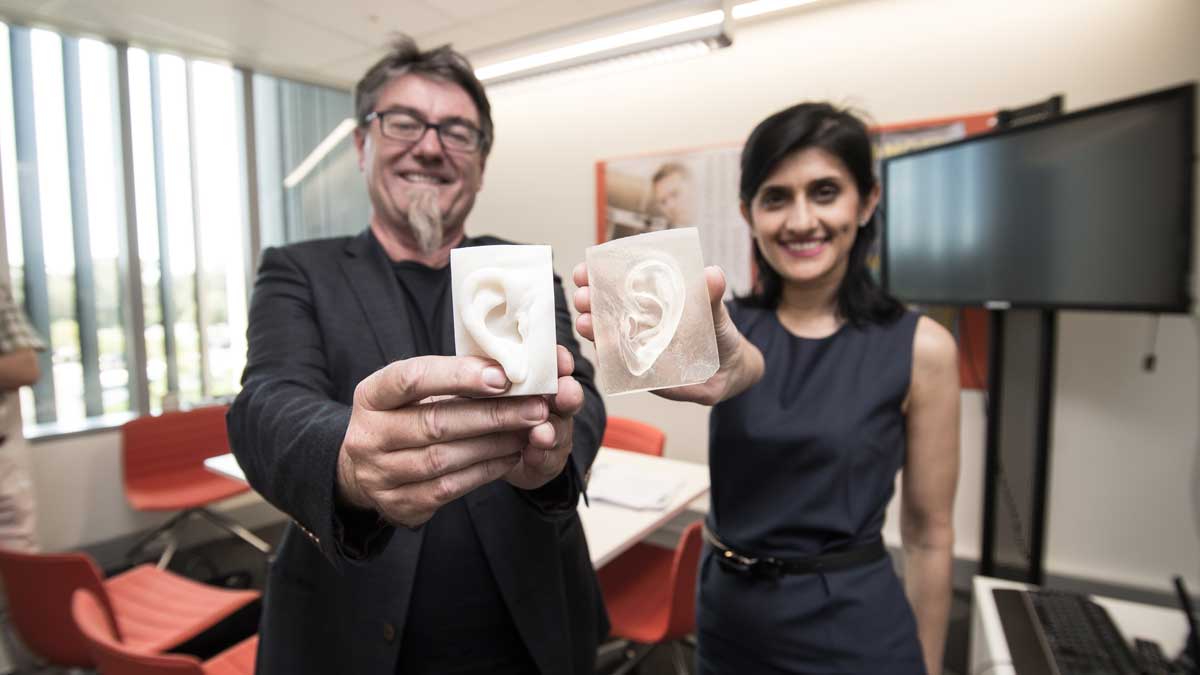
A Sydney Adventist Hospital specialist in Australia is leading a project using 3D printing technology to assist children with ear deformity.
The innovative project, called NEW EARS (iNtegrated nEtWorks for Ear Additive Reconstructive Science), is an Australian first for hybrid bioprinted ear reconstruction, achieved by integrating the science of 3D printing, cell biology, and materials engineering. The project has been named a finalist in this year’s Australian Museum Eureka Awards — the country’s most comprehensive national science awards.
NEW EARS addresses a previously challenging surgical pathway for children with ear deformity, known as microtia.
Sydney Adventist Hospital ear, nose, and throat specialist and associate professor Payal Mukherjee, who is leading the project with Gordon Wallace from the University of Wollongong, said ear deformities can significantly slow a child’s development by compromising language acquisition. In addition, ear deformities can lead to bullying and psychosocial harm.
“A child with microtia should ideally have their hearing rehabilitation surgery planned by age 4 or 5, but hearing rehabilitation and ear reconstruction are seldom coordinated, as the ear reconstruction is often delayed until the child’s ear is fully grown at around age 10,” Mukherjee explained. “With children commonly submitted to repeated surgical procedures, many become so traumatized that by their early teens they start to reject health care — even if it means living with deafness and deformed, chronically infected ears.”
The NEW EARS solution first includes research into regenerating 3D-printed ear cartilage using a technology called bioprinting, a project currently in the second phase of animal trials. The shape of the ear is uniquely crafted for each individual child. The clinical research and hospital deployment part of the study has been developed at Sydney Adventist Hospital by Mukherjee and the Wollongong team using the hospital’s onsite cell culture laboratory at the Australian Research Institute.
The team has also developed a 3D-printed prosthetic ear using silicone technology. This is an interim, low-cost, and more tangible solution for patients undergoing chemoradiotherapy after surgery. With Sophie Fleming, a clinical anaplastologist on the NEW EARS team, the researchers are running a clinical trial on this device.
“In both the bio-ear and the prosthetic silicone ear, because these are 3D printed, age is no restriction anymore, which means children with microtia can get their hearing back sooner,” Mukherjee said. “Other benefits include remote planning and, importantly, access for rural and remote patients. Cost is minimized, as are the number of trips to the clinic as technology and clinical services are developed side-by-side in this project. The prosthetic ear is a very important option for patients who are recovering from morbid resections for head and neck cancer.
“We continue to innovate the efficiency by which we deliver care to restore both the structure and the function of the ear,” Mukherjee added. “Digital solutions are allowing us to care for interstate and international patients, which we are feeding back into the research pathway to improve any technology barriers that prevent future access.”
The 3D printing using cartilage and other biomaterials is a rapidly developing field, and the NEW EARS project has been able to overcome the major challenge of replicating the complex 3D ear structure unique to each patient, Sydney Adventist Hospital leaders said. It is also a celebration of the impact that interdisciplinary teams with diverse skill sets from a variety of institutions can make to deliver patient-focused innovations, they said.
The original version of this story was posted by Adventist Record.